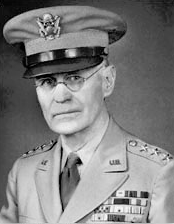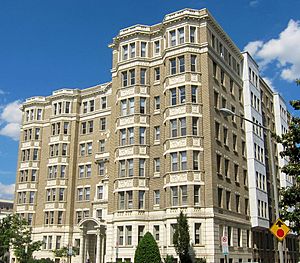John L. DeWitt facts for kids
Quick facts for kids
John Lesesne DeWitt
|
|
|---|---|

LTG John L. DeWitt
|
|
| Born | January 9, 1880 Fort Sidney, Nebraska, US |
| Died | June 20, 1962 (aged 82) Washington, D.C., US |
| Place of burial | |
| Allegiance | United States |
| Service/ |
|
| Years of service | 1898–1947 |
| Rank | |
| Commands held | Quartermaster General of the U.S. Army; Commandant of the Army War College; Fourth U.S. Army, Commanding General; Western Defense Command, Commanding General; Commandant of the Army and Navy Staff College |
| Battles/wars | World War I, World War II |
| Awards | Distinguished Service Medal |
John Lesesne DeWitt (born January 9, 1880 – died June 20, 1962) was a high-ranking general officer in the United States Army. He is most known for his role in leading the forced relocation and internment of Japanese Americans during World War II.
After the attack on Pearl Harbor in December 1941, General DeWitt believed that Japanese people living on the West Coast of the United States might try to harm the American war effort. He suggested they be moved away from coastal areas. President Franklin D. Roosevelt then issued Executive Order 9066. This order allowed military leaders to restrict access to sensitive locations. General DeWitt used this power to declare most of the West Coast off-limits to Japanese Americans. This led to about 110,000 Japanese men, women, and children being forced into internment camps. Most of these people were American citizens.
Contents
Early Life and Family
John L. DeWitt was born in Fort Sidney, Nebraska, on January 9, 1880. His father, Calvin DeWitt, was also a general in the U.S. Army. His mother was Josephine (Lesesne) DeWitt. John had an older brother, Wallace, a younger sister, Mary Wallace, and a younger brother, Calvin Jr.. His family had Dutch roots.
Military Career Highlights
DeWitt joined the U.S. Army as a second lieutenant in 1898. He served for almost 50 years, until 1947. Before joining the Army, he attended Princeton University.
His early military work included serving during the Philippine Insurrection and in the Mexican Punitive Expedition.
Service in World War I
In 1918, DeWitt went to France with the 42nd Division during World War I. He worked as a quartermaster, which meant he was in charge of supplies for the division. Other famous people in this division included Douglas MacArthur. In July 1918, DeWitt was promoted to full colonel. He received the Distinguished Service Medal for his service at the end of the war.
Between the World Wars
From 1919 to 1930, DeWitt continued to work in supply roles. In 1930, he became a major general and was put in charge of all supplies for the U.S. Army as the Quartermaster General. He also helped organize the Gold Star Mothers' Pilgrimage. This was a trip for mothers whose sons died in France during World War I to visit their graves.
Later, he took command of the Philippine Division. In 1937, he became the head of the Army War College. In December 1939, he was promoted to lieutenant general. He then took command of the Fourth Army and the Western Defense Command. This meant he was responsible for protecting the West Coast of the United States from any attack by Japan.
World War II Actions
When World War II began, General DeWitt was 62 years old. He wrote a report called "Final Report: Japanese Evacuation from the West Coast, 1942." This report argued for the removal and internment of American citizens who had Japanese ancestors.
It's important to note that after more than 100,000 Japanese Americans were interned, no cases of spying were ever found.
From 1939 to 1943, DeWitt was in charge of the Western Defense Command, based in San Francisco.
On December 8, 1941, the day after the attack on Pearl Harbor, air raid sirens went off in San Francisco. People thought Japanese warplanes were seen over San Francisco Bay. DeWitt was very upset that the city wasn't prepared for a blackout. He told city leaders that "Death and destruction are likely to come to this city at any moment." He believed the planes were Japanese and said, "Unless definite and stern action is taken... a great deal of destruction will come."
DeWitt even suggested it might have been good if bombs had been dropped to "awaken this city." He also recommended that the 1942 Rose Bowl football game be moved from Pasadena, California. He worried that a large crowd would be an easy target for Japanese planes. So, for the only time in its history, the 1942 Rose Bowl was played in North Carolina.
Internment of Japanese Americans
In December 1941, General DeWitt suggested that all foreign nationals from enemy countries, aged 14 and older, should be moved inland. Initially, he wasn't sure about including American citizens. However, after a report in January 1942 suggested widespread spying by people of Japanese ancestry in Hawaii, he became a strong supporter of interning Japanese, and at first, even German and Italian Americans. He believed that the lack of sabotage meant something bigger was being planned.
In February 1942, DeWitt told President Franklin D. Roosevelt that no spying by Japanese Americans had been confirmed. But he said this only showed "a disturbing and confirming indication that such action will be taken." He recommended moving all Japanese people from the coastal areas of California, Oregon, Washington, and Alaska. Using Executive Order 9066, DeWitt started a plan to identify, gather, and move these "undesirables."
On March 2, 1942, DeWitt issued "Military Proclamation No. 1." This order made parts of California, Oregon, and Washington "military area no. 1." It also required any person of Japanese ancestry who moved to report their new address. Days later, DeWitt announced that land near Manzanar, California, would be used to build a "reception center." This center would be a temporary stop before people were moved to more permanent places. On March 6, Executive Order 9066 was also applied to all Japanese people living in Alaska.
The forced relocation began on March 23, 1942, starting with citizens in Los Angeles. General DeWitt issued new orders for Japanese Americans, setting an 8 p.m. to 6 a.m. curfew. It also banned them from owning firearms, radios, and cameras. DeWitt warned that "anything but strict compliance... will bring immediate punishment." People in specific areas had to report to a "Civil Control Station," then they were taken to an Assembly Center for relocation.
In total, DeWitt ordered the forced removal and internment of 110,000 people of Japanese descent. They were moved from their homes on the West Coast to internment camps further inland. DeWitt famously stated that a person of Japanese ancestry was "a Jap," whether they were a U.S. citizen or not.
A judge in Oregon, James Alger Fee, ruled in November 1943 that American citizens could not be held without martial law. DeWitt responded that "All military orders and proclamations of this headquarters remain in full force and effect."
After the Japanese Americans were moved, DeWitt lifted curfew rules for Italian Americans in October and for German Americans in December.
DeWitt was against efforts to decide which Japanese Americans were loyal and which were not. He also opposed creating an all-Japanese combat unit. In 1943, he told Congress he would "use every proper means" to stop Japanese Americans from returning to the West Coast after the war. His report, written with Colonel Karl Bendetsen, stated that it was impossible to know the loyalty of people of Japanese ancestry because of their race. This, he argued, made internment necessary. The original version of this report was so offensive that Bendetsen ordered all copies to be destroyed.
However, in 1980, a copy of the original report was found. This report, along with other evidence, showed that the government had hidden information during court cases. This information would have proved there was no military reason for the forced removal and internment of Japanese Americans. Because of this, the convictions of Fred Korematsu, Gordon Hirabayashi, and Minoru Yasui were overturned.
Other Duties
DeWitt's orders also affected other parts of life on the West Coast. For example, deer hunting and outdoor sports at night were banned. An office was set up in Alaska to issue permits for anyone traveling into or out of the territory.
DeWitt also oversaw military operations in the Aleutian Islands, where some islands had been taken over by Japanese forces. After his time leading the Western Defense Command, he became the head of the Army and Navy Staff College in Washington, D.C. He retired from the Army in June 1947.
After Retirement
On July 19, 1954, DeWitt was promoted to a full general by a special act of Congress. This was to recognize his service in World War II.
John L. DeWitt passed away in Washington, D.C., on June 20, 1962, from a heart attack. He is buried in Arlington National Cemetery.
Personal Life
On June 3, 1903, John DeWitt married Martha Estes. They had one son, John Lesesne DeWitt Jr.
Awards and Honors
- Army Distinguished Service Medal with oak leaf cluster
- Navy Distinguished Service Medal
- Philippine Campaign Medal
- Mexican Service Medal
- Victory Medal with seven campaign clasps
- American Defense Service Medal with star
- American Campaign Medal
- Asiatic-Pacific Campaign Medal with one campaign star
- World War II Victory Medal
- Order of the Aztec Eagle (Mexico)
Dates of Rank
| No insignia in 1898 | Second lieutenant, Regular Army: October 10, 1898 |
| First lieutenant, Regular Army: January 29, 1900 | |
| Captain, Regular Army: May 25, 1906 | |
| Major, Regular Army: May 15, 1917 | |
| Lieutenant colonel, National Army: August 5, 1917 | |
| Colonel, Regular Army: July 30, 1918 | |
| Major, Regular Army: August 1, 1919 | |
| Lieutenant colonel, Regular Army: July 1, 1920 | |
| Colonel, Regular Army: May 9, 1921 | |
| Major general, Temporary: January 18, 1930 | |
| Colonel, Regular Army: February 2, 1934 | |
| Brigadier general, Regular Army: March 26, 1934 | |
| Major general, Regular Army: December 1, 1936 | |
| Lieutenant general, Temporary: December 5, 1939 | |
| Lieutenant general, Retired List: January 31, 1944 | |
| Lieutenant general, Active Duty: February 1, 1944 | |
| Lieutenant general, Retired List: June 10, 1947 | |
| General, Retired List: July 19, 1954 |


